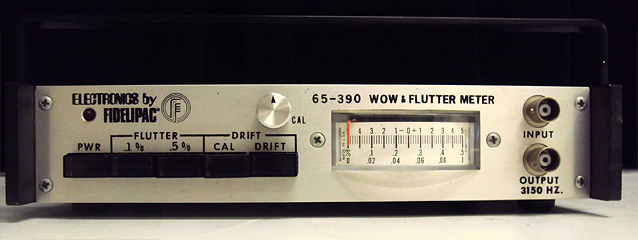miroslav
Cosmic Cowboy
Wondering if anyone here has used any particular models to adjust their capstans?
I just picked up this Fidelipac unit on eBay for like $20.


Main reason I got is because I also have a spare capstan motor for my MX-80, and it's a newer one than what is on my machine currently, and it might be just a pinch even quieter than mine, though my stock capstan is running fine for now.
Anyway...I tried the new capstan motor out on the deck, but noticed that there was a small amount of flutter on playback...which is normal, since the motor has electronic dampening adjustment trims that need to be fine-tuned via the Capstan Contorl PCB in the back of the deck...but you need a Wow & Flutter meter to do that.
I also have a spare Capstan Control PCB...so I figured I would leave the stock motor and control PCB as one set...and then drop the "new" motor in and spare control PCB and set them up as another set. That way, if ever the need, I can simply switch out both motor and control PCB...which is maybe a 20 minute job.
I have yet to try this Fidelipac meter...but I did plug it in and it appears to be working OK. It is certainly a much more simpler/streamlined Wow & Flutter meter than many of the other units I've seen for sale on eBay, and I was curious if anyone here was familiar with this or other units. The more involved units usually have multiple measuring/metering options...most of which I don't need. This Fidelipac has exactly the options my MX-80 manual calls for...so hopefully it will be a breeze using it.
I just picked up this Fidelipac unit on eBay for like $20.



Main reason I got is because I also have a spare capstan motor for my MX-80, and it's a newer one than what is on my machine currently, and it might be just a pinch even quieter than mine, though my stock capstan is running fine for now.
Anyway...I tried the new capstan motor out on the deck, but noticed that there was a small amount of flutter on playback...which is normal, since the motor has electronic dampening adjustment trims that need to be fine-tuned via the Capstan Contorl PCB in the back of the deck...but you need a Wow & Flutter meter to do that.
I also have a spare Capstan Control PCB...so I figured I would leave the stock motor and control PCB as one set...and then drop the "new" motor in and spare control PCB and set them up as another set. That way, if ever the need, I can simply switch out both motor and control PCB...which is maybe a 20 minute job.
I have yet to try this Fidelipac meter...but I did plug it in and it appears to be working OK. It is certainly a much more simpler/streamlined Wow & Flutter meter than many of the other units I've seen for sale on eBay, and I was curious if anyone here was familiar with this or other units. The more involved units usually have multiple measuring/metering options...most of which I don't need. This Fidelipac has exactly the options my MX-80 manual calls for...so hopefully it will be a breeze using it.




